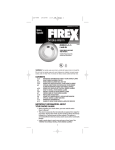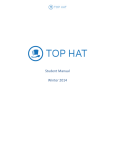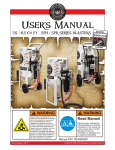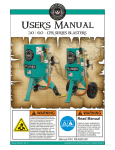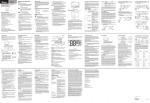Download Kidde I4618 User's Manual
Transcript
110-1082B 12/12/06 4:01 PM Page 1 120V AC Ionization Smoke Alarm with 9V Battery Back-up 110-1082B MODEL FADC PLEASE READ AND SAVE THIS MANUAL Installer: Please leave this manual with the product. TIN OF O CALIF G RN AT HA ST L IA STA TE IS E S E S L FIRE M A R R V I C E The ionization type alarms are generally more effective at detecting fast, flaming fires which consume combustible materials rapidly and spread quickly. Sources of these fires may include flammable liquids or paper burning in a waste container. The photoelectric type alarms are generally more effective at detecting slow, smoldering fires which smolder for hours before bursting into flame. Sources of these fires may include cigarettes burning in couches or bedding. However, both types of alarms are designed to provide adequate detection of both types of fires. If you desire the benefits of both systems, you should install smoke alarms that combine in one alarm both photoelectric and ionization sensing technologies. SMOKE ALARM FEATURES • This smoke alarm is powered by 120V AC and a 9-volt battery back-up source. AC/DC smoke alarms offer added protection in the event of a power failure or a drained battery. • Unique power connector prevents interconnection with incompatible smoke alarms or security systems. • This smoke alarm may be interconnected with as many as 11 other Firex model FADC, AD, ADC, PAD or FX1218 smoke alarms, and as many as 6 Firex model ADH heat alarms for a total of not more than 18 interconnected devices. • Optional tamper-resist feature can serve as a safeguard against tampering. • The smoke alarm will sound a short beep about once a minute if the battery is weak or improperly connected. Item 4718 also blinks the red LED 4 times each minute to help identify the alarm. • Green and red LED indicator(s) show when the smoke alarm is receiving AC power, working under normal operation, in alarm, or under false alarm control. • Loud alarm horn—85 decibels at 10 feet—sounds to alert you to an emergency. • This alarm incorporates the internationally recognized horn signal for evacuation. During alarm mode, the horn produces three short beeps followed by a 2 second pause and then repeats. This pattern is somewhat different than the previous alarm sound, which continually beeped. • Test button checks smoke alarm operation and activates False Alarm Control feature which quiets unwanted alarms for up to 15 minutes. • Item 4718 features a latching LED which blinks the initiating alarm’s red LED 3 times each minute until manually reset. • Item 4718 has a ramp-up test horn feature which emits 2 reduced-volume beeps before reaching the full 85db level during testing. 1 110-1082B 12/12/06 4:01 PM Page 2 IMPORTANT SAFETY INFORMATION PLEASE READ AND SAVE THESE INSTRUCTIONS ! W A R N I N G • This smoke alarm requires constant 120-volt, AC power AND a working 9-volt battery to operate properly. This smoke alarm WILL NOT work if AC power is not connected or has failed or been interrupted for any reason AND the battery is removed, drained or improperly connected. DO NOT use any other kind of battery except as specified in this manual. DO NOT connect this smoke alarm to any other type of smoke alarm or auxiliary device, except those listed in this manual. • DO NOT remove or disconnect battery or turn off AC power to quiet unwanted alarms. This will remove your protection. Open windows or fan the air around smoke alarm to silence it. This smoke alarm features a False Alarm Control button which, when activated, will quiet unwanted alarms for up to 15 minutes. • The Push-to-Test button accurately tests all smoke alarm functions. DO NOT use any other test method. Test smoke alarm weekly to ensure proper operation. • This smoke alarm should be installed only by a licensed, qualified electrician. Observe and follow all local and national electrical and building codes for installation. • This smoke alarm is designed to be used inside a single family household only. In multi-family buildings, each individual living unit should have its own smoke alarms. Do not install in non-residential buildings or places which house many people like hotels, motels, dormitories, hospitals, nursing homes, or group homes of any kind. This smoke alarm is not a substitute for a complete alarm system. • Install a smoke alarm in every room and on every level of the home. Smoke may not reach the smoke alarm for many reasons. For example, if a fire starts in a remote part of the home, on another level, in a chimney, wall, roof, or on the other side of a closed door, smoke may not reach the smoke alarm in time to alert household members. A smoke alarm will not promptly detect a fire EXCEPT in the area or room in which it is installed. • Interconnected smoke alarms installed in every room and on every level of the household offer maximum protection. The National Fire Protection Agency (NFPA) recommends interconnecting smoke alarms so that when one smoke alarm senses smoke and sounds its alarm, all others will sound as well. Do not interconnect smoke alarms from one individual family living unit to another. Do not connect this smoke alarm to any other type of alarm or auxiliary device. • Smoke alarms may not alert every household member every time. There may be limiting circumstances where a household member may not hear the alarm (e.g., outdoor or indoor noise, sound sleepers, drug or alcohol usage, the hard of hearing, etc.). If you suspect that this smoke alarm may not alert a household member, install and maintain specialty smoke alarms. Current studies have shown smoke alarms may not awaken all sleeping individuals, and that it is the responsibility of individuals in the household that are capable of assisting others to provide assistance to those who may not be awakened by the alarm sound, or to those who may be incapable of safely evacuating the area unassisted. • Smoke alarms can sound their alarms only when they detect smoke. Smoke alarms detect combustion particles in the air. They do not sense heat, flame, or gas. This smoke alarm is designed to give audible warning of a developing fire. However, many fires are 2 110-1082B 12/12/06 4:01 PM Page 3 fast-burning, explosive, or intentional. Others are caused by carelessness or safety hazards. Smoke may not reach the smoke alarm QUICKLY ENOUGH to ensure safe escape. • Smoke alarms have limitations. This smoke alarm is not foolproof and is not warranted to protect lives or property from fire. Smoke alarms are not a substitute for insurance. Homeowners and renters should insure their life and property. In addition, it is possible for the smoke alarm to fail at any time. For this reason, you must test the smoke alarm weekly and replace every 10 years. • Smoke alarms must not be used with detector guards unless the combination of alarm and guard has been evaluated and found suitable for that purpose. SMOKE ALARM PLACEMENT Invensys Controls Americas recommends complete coverage protection achieved by installing a smoke alarm in every room of your home. The National Fire Protection Association’s (NFPA) minimum requirement, as stated in Standard 72, Chapter 2, reads as follows: “2-2.1.1.1 Smoke detectors shall be installed outside of each separate sleeping area in the immediate vicinity of the bedrooms and on each additional story of the family living unit including basements and excluding crawl spaces and unfinished attics. In new construction a smoke detector also shall be installed in each sleeping room.” Chapter 2 also reads as follows: DINING KITCHEN ROOM “2-2.2.1 In new construction, where more than one smoke detector is required by 2-2.1, they shall be so LIVING ROOM arranged that operation of any smoke detector shall cause the alarm in all smoke detectors within the dwelling to sound.” BEDROOM BEDROOM BEDROOM The NFPA, 1993 Edition, Appendix A further states: BEDROOM HALL BEDROOM “The required number of smoke detectors may not provide reliable early warning protection for those areas separated by a door from the areas protected by the required smoke detectors. For this reason, it is recommended that the householder DINING KITCHEN BEDROOM ROOM consider the use of additional TV ROOM LIVING ROOM smoke detectors for those areas BEDROOM for increased protection. The BEDROOM additional areas include: basement, bedrooms, dining room, furnace room, utility room, and hallways not protected by the required smoke detectors.” LIVING ROOM DINING ROOM BASEMENT Also, as required by the California State Fire Marshal: “Early warning fire detection is best achieved by the installation of fire detection equipment in all rooms and areas of the household as follows: a smoke detector installed in each separate sleeping area (in the vicinity, but outside the bedrooms), and heat or smoke detectors in the living rooms, dining rooms, bedrooms, kitchens, hallways, attics, furnace rooms, closets, utility and storage rooms, basements and attached garages.” 3 110-1082B 12/12/06 4:01 PM Page 4 FOR BEST PROTECTION, WE RECOMMEND THAT YOU INSTALL A SMOKE ALARM IN EVERY ROOM. In addition, we recommend that all smoke alarms be interconnected. Typical Efficiency Home (Apartment) • Install a smoke alarm on the ceiling or wall closest to the sleeping area. MOBILE HOME Typical Mobile Home NOTE: For mobile homes built before 1978, install smoke alarms on an inside wall between 4 and 12 inches from the ceiling. (Older mobile homes have little or no insulation in the ceiling.) This is especially important if the ceiling is unusually hot or cold. Install a smoke alarm inside each bedroom and in the hallway • outside each separate sleeping area. Typical Single-Story Home • Install a smoke alarm on the ceiling or wall inside each bedroom and in the hallway outside each separate sleeping area. If a bedroom area hallway is more than 30 feet long, install a smoke alarm at each end. If there is a basement: • Install a smoke alarm on the basement ceiling at the bottom of the stairwell. Typical Two-Story or Split Level Home • Install a smoke alarm on the ceiling or wall inside each bedroom and in the hallway outside each separate sleeping area. If a bedroom area hallway is more than 30 feet long, install a smoke alarm at each end. • Install a smoke alarm at the top of a first-to-second floor stairwell. If there is a basement: • Install a smoke alarm on the basement ceiling at the bottom of the stairwell. Key • Smoke Alarm Smoke Alarm with False Alarm Control 4 110-1082B 12/12/06 4:01 PM Page 5 IMPORTANT SMOKE ALARM PLACEMENT AND EXCEPTION INFORMATION • Install a smoke alarm as close to • • • • the center of the ceiling as possible. If this is not practical, mount no closer than 4 inches from a wall or corner. Also, if local codes allow, install smoke alarms on walls, between 4 and 12 inches from ceiling/wall intersections. Install a minimum of two smoke alarms in every home, no matter how small the home. New construction codes require a minimum of two interconnected smoke alarms in newly built homes. Install a smoke alarm in each room that is divided by a partial wall (either coming down from the ceiling at least 24 inches, or coming up from the floor). Install smoke alarms on peaked, cathedral, or gabled ceilings 3 feet from the highest point (measured horizontally). Install a smoke alarm in lived-in attics or attics which house electrical equipment like furnaces, air conditioners, or heaters. DO NOT install smoke alarm: Near appliances or areas where normal combustion regularly occurs (kitchens, near furnaces, hot water heaters). Use specialized smoke alarms with unwanted alarm control for these areas. In areas with high humidity, like bathrooms or areas near dishwashers or washing machines, install at least 10 feet (3 meters) away from these areas, if possible. Within 3 ft. horizontally from heating and cooling supply vents and outside of the air flow from these registers. The air could blow smoke away from the detector, interrupting its alarm. In rooms where temperatures may fall below 40°F (4°C) or rise above 100°F (38°C). In extremely dusty, dirty, or insect-infested areas. Loose particles interfere with smoke alarm operation. 5 110-1082B 12/12/06 4:01 PM Page 6 HOW TO INSTALL THIS SMOKE ALARM ! DANGER: ELECTRICAL SHOCK HAZARD. Turn off power at the main fuse box or circuit breaker by removing the fuse or switching the circuit breaker to the OFF position. ! WARNING: This smoke alarm should be installed only by a qualified electrician. Smoke alarm wiring to be used shall be in accordance with the provisions of Article 210 and 760 of the National Electrical Code, ANSI/NFPA 70, and any local codes that may apply. Interconnect wire location shall be in accordance with NEC Article 300.3b. THIS SMOKE ALARM SHOULD BE INSTALLED IN ACCORDANCE WITH THE NATIONAL FIRE PROTECTION ASSOCIATION’S STANDARD 72 (National Fire Protection Association, One Batterymarch Park, Quincy, MA 02269). • Install smoke alarm on a 4-inch octagon or single gang junction box only. 1. From back of smoke alarm, remove mounting plate. To later engage tamper-resist feature, twist out and set aside one of the pins molded into the plate. Both pins are exactly the same. 2. Align recessed slots on plate with mounting holes of a 4-inch octagon or single gang junction box. 3. Gently pull household wires through center hole of plate. 4. Secure plate to junction box using mounting screws. 5. With a small wire connector, connect white wire from connector plug to white household wire. 6. Connect black wire from connector plug to black household wire. 7. If interconnection is desired, connect yellow wire from connector to interconnect wire between smoke alarms. See section, “INTERCONNECTING SMOKE ALARMS.” NOTE: If this will be a single-station smoke alarm, cover yellow wire with electrical tape and tuck into junction box. 8. Attach connector plug to pins on back of smoke alarm. Plug will only fit one way and will snap into place. Battery 9. Gently tug connector to be sure it is attached securely. Battery Door Remove thin plastic 6 FADC 110-1082B 12/12/06 4:01 PM Page 7 10. Position smoke alarm to mounting plate and turn clockwise to lock into place. For tamper-resist, use long-nosed pliers to remove thin plastic from notch on smoke alarm edge. Insert pin into notch on edge of smoke alarm after smoke alarm is positioned properly in base. Insert pin here Remove pin from here 11. Remove arrow tab and close battery door. Smoke alarm may beep briefly as door is closed. 12. Turn on power at main fuse box or circuit breaker. 13. Test smoke alarm. See “TESTING THE SMOKE ALARM.” WHITE WHITE YELLOW YELLOW BLACK BLACK WHITE BLACK TO GROUND TO 120 VAC INTERCONNECTING SMOKE ALARMS • This smoke alarm may be interconnected with as many as 11 • other Firex model FADC, AD, ADC, PAD or FX1218 smoke alarms, and as many as 6 Firex model ADH heat alarms for a total of not more than 18 interconnected devices. DO NOT connect to any other type or model smoke alarm. Connect smoke alarms to a single AC branch circuit. If local codes do not permit, be sure the neutral wire is common to both phases. LED INDICATOR(S) Model FADC features one combined LED indicator. The following section explains what condition the LED indicator is describing: • Constant GREEN on • GREEN is off • RED blinks once a minute - AC power is present - AC power is NOT present - testing for presence of good battery • RED blinks once a second - smoke alarm senses smoke and simultaneously sounds an alarm • RED blinks once every 10 - smoke alarm is quieting an seconds unwanted alarm (Models ADC and FADC only) • RED is off and detector in alarm - another smoke alarm in the (interconnected systems only) network has sensed smoke and is signaling this alarm. Item 4718 only • RED blinks 3 times every minute - indicates this unit initiated an alarm in an interconnected system (press the test button to reset). • RED blinks 4 times every minute - indicates weak or improperly preceded by an audible chirp connected battery. 7 110-1082B 12/12/06 4:01 PM Page 8 FALSE ALARM CONTROL Model FADC features a False Alarm Control that, when activated, quiets unwanted alarms for up to 15 minutes. To use the False Alarm Control: Press and release the test button during an unwanted alarm. The alarm should stop within ten seconds. The RED LED will blink once every 10 seconds. This means the smoke alarm is in False Alarm Control. For Item 4718, the initiating alarm RED LED in an interconnected system will continue to blink until reset by pressing the test button. When there are multiple units interconnected, each alarm that is sensing smoke must have its test button depressed in order to silence the remaining alarms. If the smoke alarm(s) does not go into False Alarm Control and continues to sound its loud alarm horn, or if it initially goes into False Alarm Control™ then resounds the alarm, the smoke is too heavy and could be a dangerous situation — take emergency action. TESTING THE SMOKE ALARM ! W A R N I N G • Test each smoke alarm to be sure it is installed correctly and operating properly. • Test all smoke alarms in an interconnected system after installation. • The Push-to-Test button accurately tests all functions. DO NOT use an open flame to test this smoke alarm. You may ignite and damage the smoke alarm or your home. • Test smoke alarms weekly and upon returning from vacation or when no one has been in the household for several days. FIELD TESTING IMPORTANT NOTICE: When testing is required in the field by local inspectors or other parties, it should be done using only the Smoke Detector Sensitivity Analyzer model #501-1 manufactured by Gemini Scientific Corporation. Follow the Gemini test and set-up instructions provided by the manufacturer, and use the obscuration limits provided on the back of the smoke alarm. Refer to the smoke alarm’s instruction manual for maintenance and push-to-test operation. Go / No-Go Testing A functional Go / No-Go test can be performed on the unit by using Smoke Detector Teste model #25S, manufactured for Home Safeguard Industries, Inc. Follow the instructions included on the tester. Test all smoke alarms weekly by doing the following: 1. Observe the green LED. A constant green light indicates the smoke alarm is receiving 120V AC power. 2. Firmly depress the Push-to-Test button for at least five (5) seconds. On Item 4718, the smoke alarm will sound 2 short, reduced-volume beeps, and then 1 short loud beep, followed by a pause, then repeats. All other items will sound 3 short loud beeps followed by a 2-second pause and then repeats. The alarm may sound for up to 10 seconds after releasing the Push-to-Test button. 8 110-1082B 12/12/06 4:01 PM Page 9 NOTE: If smoke alarms are interconnected, all smoke alarms should sound an alarm within three seconds after any test button is pushed and the tested smoke alarm sounds. 3. If smoke alarm does not sound, turn off power at main fuse box or circuit breaker and check wiring. Retest smoke alarm. ! DANGER: If alarm horn sounds, and smoke alarm is not being tested, the smoke alarm is sensing smoke. THE SOUND OF THE ALARM HORN REQUIRES YOUR IMMEDIATE ATTENTION AND ACTION. MAINTENANCE AND CLEANING In addition to weekly testing, this smoke alarm requires yearly battery replacement and periodic cleaning to remove dust, dirt, and debris. ! DANGER: ELECTRICAL SHOCK HAZARD. Turn off power at main service panel by removing fuse or switching appropriate circuit breaker to OFF position before replacing battery or cleaning smoke alarm. BATTERY REPLACEMENT Always turn off power to smoke alarm before replacing battery. Replace battery at least once a year or immediately when the low battery chirp sounds once a minute, even though the smoke alarm is receiving AC power. On item 4718 the red LED will also blink 4 times every minute after each low battery chirp. Use only the following batteries as replacements in this smoke alarm: Eveready 522 or 1222, Duracell MN 1604 or Ultralife U9VL-J. ! WARNING: DO NOT USE ANY OTHER TYPE OF BATTERY, EXCEPT AS SPECIFIED IN THIS MANUAL. DO NOT USE RECHARGEABLE BATTERIES. 1. Turn off power to smoke alarm at main service panel. 2. Slide battery door open as shown on page 6 in the installation section. 3. Remove drained battery from compartment and discard. 4. Install a fresh 9-volt battery. 5. Slide battery door closed. 6. Turn on power and test smoke alarm using Push-to-Test button. CLEANING Clean the smoke alarm at least once a month to remove dust, dirt, or debris. Always turn off power to smoke alarm before cleaning. • Using the soft brush or wand attachment to a vacuum cleaner, vacuum all sides and cover of smoke alarm. Be sure all the vents are free of debris. If • necessary, turn off power and use a damp cloth to clean smoke alarm cover. IMPORTANT: Do not attempt to remove the cover or clean inside the smoke alarm. THIS WILL VOID YOUR WARRANTY. 9 110-1082B 12/12/06 4:01 PM Page 10 REPAIR ! CAUTION: Do not attempt to repair this smoke alarm. Doing so will void your warranty. If smoke alarm is not operating properly, see “TROUBLESHOOTING.” If necessary and if still under warranty, return smoke alarm to Invensys Controls Americas. Pack it in a well-padded carton, shipping prepaid, to: Invensys Controls Americas Product Service Department 28C Leigh Fisher Blvd. El Paso, TX 79906 If the smoke alarm is no longer under warranty, have a licensed electrician replace the smoke alarm immediately with a comparable Firex brand smoke alarm. PRACTICE FIRE SAFETY If the smoke alarm sounds its alarm horn, and you have not pushed the test button, it is warning of a dangerous situation. Your immediate response is necessary. To prepare for such occurrences, develop family escape plans, discuss them with ALL household members, and practice them regularly. • Expose everyone to the sound of a smoke alarm and explain what the sound means. • Determine TWO exits from each room and an escape route to the outside from each exit. • Teach all household members to touch the door and use an alternate exit if the door is hot. INSTRUCT THEM NOT TO OPEN THE DOOR IF THE DOOR IS HOT. • Teach household members to crawl along the floor to stay below dangerous smoke, fumes, and gases. • Determine a safe meeting place for all members outside the building. WHAT TO DO IN CASE OF A FIRE 1. Don’t panic; stay calm. 2. Leave the building as quickly as possible. Touch doors to feel if they are hot before opening them. Use an alternate exit if necessary. Crawl along the floor, and DO NOT stop to collect anything. 3. Meet at a pre-arranged meeting place outside the building. 4. Call the fire department from OUTSIDE the building. 5. DO NOT GO BACK INSIDE A BURNING BUILDING. Wait for the fire department to arrive. These guidelines will assist you in the event of a fire. However, to reduce the chance that fires will start, practice fire safety rules and prevent hazardous situations. 10 110-1082B 12/12/06 4:01 PM Page 11 TROUBLESHOOTING ! DANGER: Always turn off power at main fuse box or circuit breaker before taking troubleshooting action. ! WARNING: DO NOT disconnect battery or AC power to quiet an unwanted alarm. This will remove your protection. Fan the air or open a window to remove smoke or dust. PROBLEM Smoke alarm does not sound when tested. NOTE: Push test button for at least five (5) seconds while testing! SOLUTION 1. Check that AC power is turned on. 2. Turn off power. Remove smoke alarm from mounting plate and: a. check that connector plug is securely attached. b. check that battery is properly attached to connector. 3. Clean smoke alarm. The horn makes 2 quiet beeps and one loud beep when tested. 1. The alarm is operating correctly. Item 4718 has a ramp-up test horn feature. This allows you to release the test button before the alarm emits the loud beeps. Smoke alarm beeps about once a minute. 1. Turn off power and replace battery. (See “Battery Replacement” in the “MAINTENANCE AND CLEANING” section.) 2. On Item 4718 only. Be sure red LED is extinguished after replacing battery. Smoke alarm sounds unwanted alarms intermittently or when residents are cooking, taking showers, etc. 1. Hire an electrician to move smoke alarm to a new location. See “SMOKE ALARM PLACEMENT” 2. Clean smoke alarm. See “Cleaning” in the “MAINTENANCE AND CLEANING” section. Interconnected smoke alarms do not sound when system is tested. 1. Press and hold test button for at least three seconds after the first unit sounds. 11 110-1082B 12/12/06 4:01 PM Page 12 WARRANTY INFORMATION 5-YEAR LIMITED SMOKE ALARM WARRANTY AND 10-YEAR LIMITED ULTRALIFE U9VL-J LITHIUM BATTERY WARRANTY (WHEN SOLD WITH INVENSYS CONTROLS AMERICAS SMOKE ALARM) Invensys Controls Americas warrants to the original consumer purchaser each new smoke alarm to be free from defects in material and workmanship under normal use and service for a period of five (5) years from the date of purchase. For Invensys Controls Americas smoke alarms sold with an Ultralife U9VL-J 9volt battery, Invensys Controls Americas warrants to the original consumer purchaser each new Ultralife U9VL-J 9-volt battery to be free from defects in material and workmanship under normal use and service for a period of ten (10) years from the date of purchase. Invensys Controls Americas agrees to repair or replace, at its option, any defective smoke alarm or Ultralife U9VL-J 9-volt battery (when sold with Invensys Controls Americas smoke alarm) provided that it is returned with postage prepaid and with proof of purchase date to Invensys Controls Americas. This warranty does not cover damage resulting from accident, misuse or abuse or lack of reasonable care of the product. This warranty is in lieu of all other express warranties, obligations or liabilities. THE IMPLIED WARRANTIES OF MERCHANTABILITY AND FITNESS FOR A PARTICULAR PURPOSE ARE LIMITED TO A PERIOD OF FIVE (5) YEARS FOR THE SMOKE ALARM AND TEN (10) YEARS FOR THE ULTRALIFE LITHIUM U9VL-J 9-VOLT BATTERY (WHEN SOLD WITH INVENSYS CONTROLS AMERICAS SMOKE ALARM) FROM PURCHASE DATE. Some states do not allow limitations on how long an implied warranty lasts, so the above limitations may not apply to you. IN NO CASE SHALL INVENSYS CONTROLS AMERICAS BE LIABLE FOR ANY INCIDENTAL OR CONSEQUENTIAL DAMAGES FOR BREACH OF THIS OR ANY OTHER WARRANTY, EXPRESS OR IMPLIED, WHATSOEVER, EVEN IF THE LOSS OR DAMAGE IS CAUSED BY ITS NEGLIGENCE OR FAULT. Some states do not allow the exclusion or limitation of incidental or consequential damages, so the above limitation or exclusion may not apply to you. This warranty gives you specific legal rights, and you may also have other legal rights which vary from state to state. This smoke alarm’s manufacture and distribution are licensed by the U.S. Nuclear Regulatory Commission. This product meets all the requirements of U.L. Standard 217. WHERE TO SEND YOUR SMOKE ALARM FOR SERVICE To return smoke alarms under warranty, send the smoke alarm with postage prepaid, a note describing the nature of the difficulty, and proof of date of purchase to: Invensys Controls Americas 28C Leigh Fisher Blvd. El Paso, TX 79906 United States of America To return Ultralife 10-year lithium batteries under warranty, include the lithium battery, a note describing the nature of the difficulty, with proof of date of purchase, postage and return postage prepaid to: ULTRALIFE BATTERIES, INC. c/o INVENSYS CONTROLS AMERICAS P.O. Box 622 1350 Route 88 South Newark, NY 14513 191 E. North Avenue Carol Stream, Illinois 60188 USA www.invensyscontrols.com ©2006 Invensys Controls 110-1028B 12
















